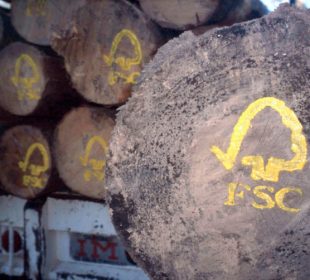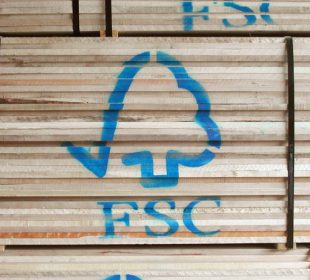More concerted actions are also now being taken by African operators and certification advocates to bolster market awareness of the benefits of these systems. FSC representatives at the Gabon Dialogue (part of the Gabon Wood Show in June) particularly emphasised the work they are doing to raise consumer awareness of the role of certification in promoting progress in line with the UN Sustainable Development Goals.
The message being sent out is that “certified tropical timber products come preloaded with rural development and environmental conservation values”. FSC were confident that this message is gaining traction, benefitting from the links to the FSC brand which has gained widespread consumer recognition in western markets.
Other agencies are now working to promote this message. With wide-ranging support from major players in the tropical wood industry, ATIBT launched a new joint marketing initiative to develop the Fair & Precious brand in 2017.
Companies that carry the brand are required to sign up to 10 environmental and social values and to demonstrate progress through commitment to FSC or PEFC certification.
With support from the Dutch government, the European Sustainable Tropical Timber Coalition (STTC) is also raising awareness of the economic, social and environmental benefits of certified tropical forest operations. STTC is working to expand the European market for certified tropical forest products by developing pan-industry partnerships, promotion of lesser known tropical species, and provision of technical advice.
This work is beginning to show results. This was highlighted in a presentation by a representative of SNCF, the French national rail network, to the Racewood conference held alongside the Gabon Wood Show in June.
The French railways need more than 12000 m3 of wood every year. Until recently tropical timbers were not used because of preconceived ideas about delayed deliveries and the risk of illegal and unsustainable harvesting.
However, partly encouraged by mounting concerns about the environmental and health impacts of creosote-coated softwood alternatives, SNBG have reconsidered their use of tropical timber. They have developed an action plan to expand application of certified tropical hardwoods in collaboration with a wide range of actors – including ATIBT, the French timber association LCB, FSC, PEFC, and WWF, together with big distributors such as Alstom, Bombadier, Nestle, Saint Gobain.
SNBG have been particularly encouraged by whole-life costing exercise which has indicated that, due to the exceptional technical properties of azobe, when all costs associated with supply, installation, maintenance, disposal, and replacement are taken into account, the tropical timber performs very well against alternatives such as creosote treated softwood and concrete.
Lower cost certification options
While these initiatives on the demand side are essential to the long-term future of the certified sustainable tropical timber business model, the recent experience of European operators in Africa also highlights the importance of ensuring the costs of certification do not create an insurmountable barrier to profitability.
To a significant extent, the certification challenges faced by operators in Africa are symptomatic of the reliance on only one international system – the FSC – and the slow evolution of regional capacity for certification. Speaking to the Racewood conference in June, Jean-Paul Grandjean of PPEFC II, an initiative of COMIFAC to encourage development of certification capacity in the Congo region, explained the many measures been taken to actively support forest operators to maintain their certificates, through training, building of certification institutions and networks, and scientific research. However, M. Grandjean also observed that a specific barrier to FSC certification in Africa was raised in 2014 with passage of Motion 45 of the FSC General Assembly on Intact Forest Landscapes (IFL).
This led to greatly tightened FSC requirements for any forest identified as an IFL, for example that lowimpact/small scale forest management and non-timber forest products must be prioritised in unallocated IFL areas, first access must be provided to local communities, and alternative models for forest management/conservation (for example for ecosystem services) must be developed within IFLs.
While the FSC requirements for IFL may appear desirable in principle, their implementation would always be extremely challenging in the business environment prevailing in the Congo region – with only limited returns to be gained from eco-system services, declining availability of the most commercially valuable species, very patchy and highly inconsistent international demand for certified wood, and lack of institutional capacity to certify large numbers of community forests.
In the light of these developments, the emergence of a new certification framework in Africa that is directly responsive to regional conditions and prioritises regional institutional capacity is a positive development.
Earlier this year, the first certificate covering an area of 600,000 hectares was awarded by PAFC Gabon, a certification system endorsed by the international PEFC in 2014 after 5 years of development.
A similar PAFC process is also now underway in Congo, where it is supported by the Ministry of Forest Economy with financial assistance from the African Development Bank. A protocol agreement was signed between PAFC and the international PEFC in 2014, and the PAFC Congo was formally constituted as an independent agency in 2017.







